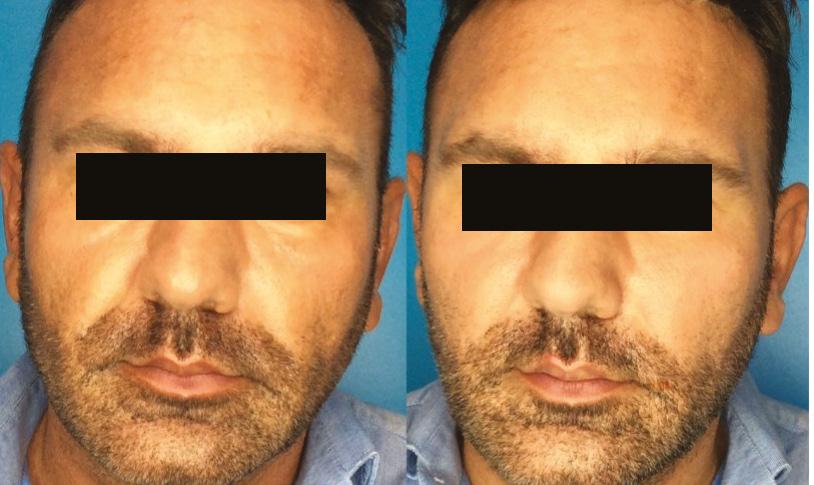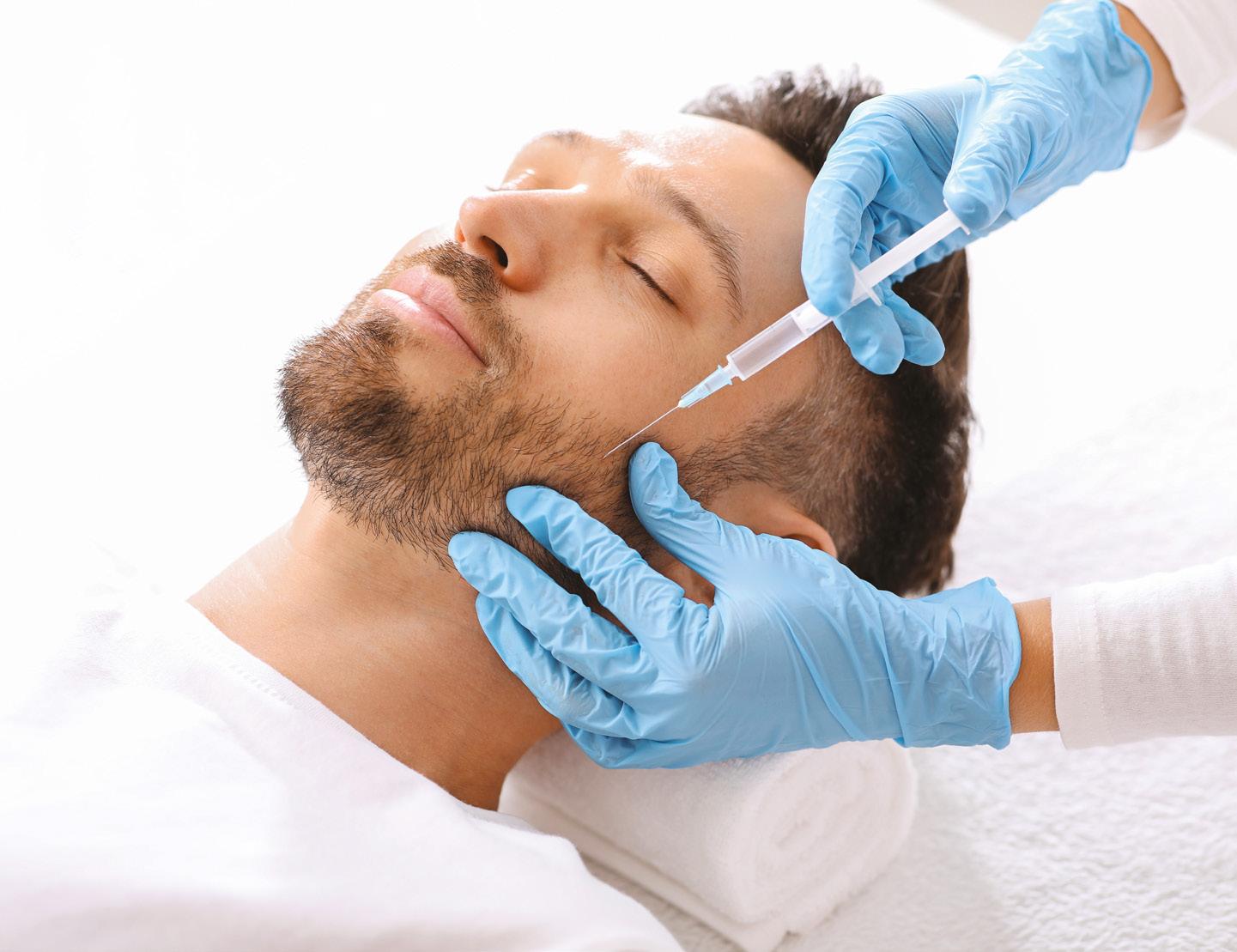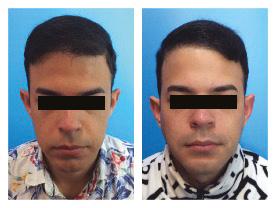
8 minute read
Treating the Male Mid-Face
Dr Xavier Goodarzian presents two case studies using collagen-stimulating fillers to restore male mid-face volume
Over the last decade aesthetic practitioners have seen increasingly more men come into our aesthetic practices, and for successful outcomes it’s important that we assess and treat them differently to women.1 In my opinion, men tend to have overall similar concerns as women do about ageing, with both genders generally requesting treatment for facial volume loss and sun damage. However men, unlike women, rarely come in and ask to have their faces ‘filled out’, as treatments like dermal fillers may have never crossed their minds. Instead, the way most men explain their concerns is by saying, ‘I look tired all the time’ or ‘I look like I have dark circles under my eyes’. So, by explaining the ageing process, facial volume loss and how dermal fillers can help this problem, we can often offer them a great solution. During the treatment it is of course important to respect the male facial anatomy by keeping the chin and jawline strong and reducing mid-face volume loss while keeping the treatment subtle.
Advertisement
Consultation In my experience, the consultation process is key to understanding the male patient’s concerns. I find men can be a bit more reserved or shy when coming into clinic, as it’s not easy for a man to walk into a traditionally female-dominated space. Often the men who come into my clinic are unaware that other men have treatments too, so it’s always good to reassure them and perhaps show some male before and afters. Men can also be quite vague when talking about their concerns, so asking more detailed questions after the introduction will allow you to discover the real reasons for attending and will shed some light on their main concerns. After hearing these, I then take a full medical history and examine the face to see what changes we can establish and how can we translate the patient’s concerns into a series of physical changes that we can then try to resolve with various treatments. Once the consultation is done, information leaflets are provided to the patient with a suggested treatment plan. The patient will have a cooling-off period before they book in for any treatments.
Treatment method and rationale When it comes to restoring facial volume, we are confronted with two options. Do we offer hyaluronic acid (HA) fillers, or do we offer a longer lasting collagen stimulator? Personally, I am happy using either type of product, but I have to admit that I tend to prefer collagen stimulators for general facial volume correction. When there is generalised facial volume loss, I find better results can be achieved with collagen stimulators because they build over time and are longer lasting. This is preferable for male patients, as they generally want something that lasts longer and does not require six-month top ups like HA fillers. Although there are several collagen-stimulating fillers on the market such as Sculptra, Radiesse and Lanluma, I choose to use Ellansé. It is made of carboxymethyl cellulose (CMC) and polycaprolactone (PCL)
Case study 1 A 40-year-old male presented to my clinic, complaining of looking tired after a 15kg weight loss. After examination, I found that there was fat loss from the medial aspect of the mid-face and hollowing of the tear trough and nasolabial area. We decided on a treatment of 4mls of Ellansé, split into two sessions (2mls per session), six weeks apart. A combination of subcutaneous linear threading and deep supraperiosteal depot technique were used with both a cannula and a needle. Deep supraperiosteal injections are best done with a needle right down to the bone surface, while subcutaneous linear threading is best done with a cannula as it reduces the risk of bruising and, in Before After my experience, is much safer than a sharp needle. Three months later, the patient showed great improvement in the midface, correcting the volume deficit in the frontal cheek area and the nasolabial folds. He was very pleased with the result, and continues to come in for Patient before and three months after treatment with 4mls of Ellansé other treatments.

microspheres, and initially acts as a dermal filler, however, over a period of three to four months, type one collagen is deposited around the microspheres, which provides a long-lasting filling effect while the CMC gel is gradually absorbed.2-8 Both CMC and PCL have been used extensively in medicine and their safety has been proven over several years. The CMC gel acts as an instant filling agent and, at the same time, as a carrier for the PCL microspheres. It has histologically been proven that the collagen is formed around the PCL spheres is a high-quality type one collagen, which is the type of collagen that we need as we get older.2-8 This product can be used supraperiosteally for deep volume correction, as well as subcutaneously for enhancing skin quality and restoring skin thickness. I am often asked by other practitioners if I am ever worried using this product as it is longer lasting and is not reversible with hyaluronidase. My answer is that most problems can be avoided by using a strict aseptic technique, knowing your anatomy, knowing your patient and, most importantly, knowing and respecting the limits of your own abilities. Hyaluronidase, although very useful at times, has given far too many of us a false sense of security in thinking that, ‘If I use a hyaluronic acid filler I can always dissolve it if it goes wrong’. Ellansé can be administered in a single session using all the required number of syringes, which varies greatly depending on the level of volume loss. However, as the swelling increases with the amount of filler you inject, if a lot of product is needed, this swelling is often not tolerated by many, especially men. In my experience, more than three syringes of Ellansé causes some noticeable swelling for up to 48 hours, which men in particular tend to dislike because they don’t want their treatment to be obvious to their friends and family. To avoid this, I tend to split the treatment into sessions to prevent over-treatment, especially as I’m injecting at high quantities. After about six or eight weeks we do notice a good level of change so it gives us an idea of how to correct at the next session. We can always add more but we cannot take the product out like we can with HA fillers, which is why I prefer a gradual approach.
Potential complications Although there is limited evidence of complications from treatment with Ellansé, as with any other injectable product there is a risk of excessive swelling, excessive bruising, prolonged tenderness, prolonged oedema, infection, abscess formation, allergic reactions, nodules, granuloma and arterial occlusion with pending necrosis.5 It is important that these potential side effects are communicated clearly to the patient during the consultation and on the consent form, as well as the actions that you would need to take to treat these in the rare chance that they occur.
Aftercare After any dermal filler treatment, it is important to advise the patient to keep the area clean and to avoid touching the face for the next four to six hours. Trying to sleep on their back with their head slightly elevated will help to reduce swelling for the first two days after treatment. For men, I advise avoiding shaving for a day or two after the treatment to avoid complications such as infections. I would also advise against rigorous exercise for a few days.
Conclusion Men have similar concerns as women with the ageing process, however I find they can be vague when it comes to explaining their specific issues. Facial volume loss is a common concern amongst both genders but men often prefer subtle and long-lasting results, so I feel collagen-stimulating fillers are a good option for this issue. Side effects may occur with any type of filler or collagen stimulator and it is important to be able to deal with them appropriately when needed.
Before After Case study 2 A 28-year-old male presented to my clinic, concerned about looking tired and with a desire to improve his chin area, which he felt was too narrow for his face shape. On examination, I saw there had been fat loss from the mid-face and a relatively underdeveloped mandible. It was decided Patient before and three and a half that the treatment plan would involve injecting months after treatment using 4mls 4mls of Ellansé split into two sessions (2mls of Ellansé per session), eight weeks apart. Again, a combination of subcutaneous linear threading and deep supraperiosteal depot technique was used with both a cannula and a needle.

Dr Xavier Goodarzian is the medical director and co-owner of the national award-winning Xavier G. Clinic in Southampton. He is a lecturer and trainer at major conferences throughout the UK and abroad, and the past lead trainer for Innomed Training. Dr Goodarzian is a member of the Royal College of General Practitioners and has postgraduate degrees in clinical dermatology and cosmetic medicine. Qual: MD(Hons), MRCGP, DipClinDerm, PGCertCosMed, MBCAM
REFERENCES
1. Terrence Keaney, The Increasing Needs of the Male, The
Dermatologist, 2013. 2. Philipp Stein, The biological basis for Sculptra-induced augmentation, 2014. 3. Nicolau P, Marijnissen-Hofste J., Neocollagenesis after injection of polycaprolactone based dermal filler in a rabbit, European
Journal of Aesthetic Medicine and Dermatology, 2013. 4. Ellansé whitepaper W113.05, Data on File 5. Christen Mo, Ellansé safety report, 2016, Data on File 6. Moers-Carpi MM, Sherwood S., Polycaprolactone for the correction of nasolabial folds: a 24-month prospective randomised controlled clinical trial, Dermatologic Surgery, 2013. 7. M. Khattar, RADIESSE VS ELLANSE, Facial volumising with
Ellansé: 1st Ellansé users meeting, 2012. 8. Gritzalaz K., Preliminary results in using a new dermal filler based on polycaprolactone, European Journal of Aesthetic
Medicine and Dermatology, 2011.










